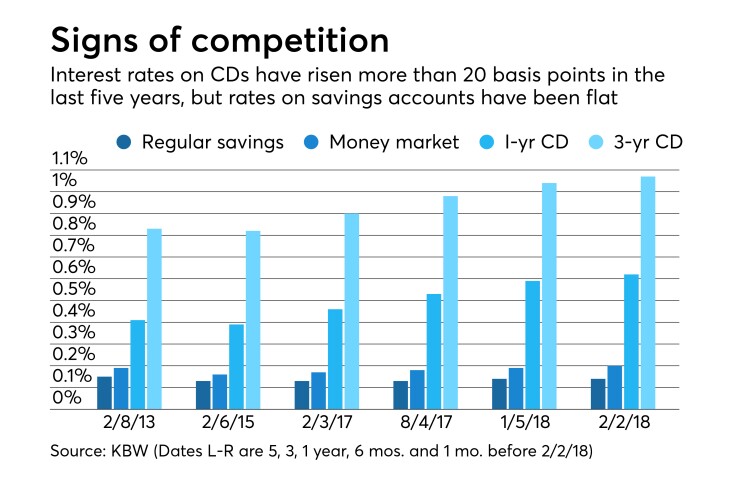Big banks have begun taking steps to protect their stockpiles of cheap deposits ahead of what could be as many as four Federal Reserve rate hikes this year.
Over the last few months, at least two of the nation’s biggest banks — Wells Fargo and Bank of America — have tinkered with the way they set deposit rates, carving up a handful of key states into smaller markets, according to Informa Research Services, a Los Angeles data firm that tracks deposit rates and promotions. The move will let the two banks more efficiently counter attempts by local competitors, such as small banks and credit unions, to lure customers away with deposit promotions.
Other big banks, meanwhile, are exploring new ways to use data and analytics to adjust rates for lucrative customer segments. For instance, some are offering promotions to affluent millennials who may be tempted to open higher-yielding accounts at online banks, observers said.
Taken together, the moves illustrate how the industry’s biggest players are becoming more precise and tech-savvy in setting deposit rates — and how they plan to respond once the federal funds rate rises enough to spur more intense competition for consumer deposits.
“Pricing is not just setting a rate sheet and pushing out to your branch and hoping it goes well,” said Brian Buckingham, vice president of U.S. deposits at Nomis Solutions, a financial pricing firm in Silicon Valley.

Over the past few years, much has been made in the industry about how the rise of smartphones and digital banking has changed the competitive landscape because they allow consumers to move money between banks more easily.
But things have changed for banks, too. Compared to the last time interest rates were on the rise a decade ago, banks s
“What is different this time is banks have much, much better data,” said Deepak Goyal, a partner in the financial services practice at Boston Consulting Group. He added that they are in the “early stages” of figuring out how best to use it.
The focus on deposits comes rates remain at rock bottom for most retail savers.
Consumers have grown accustomed to measly returns on their savings accounts, even though the
The national average rate on regular savings accounts has remained stuck around 0.14% for the past five years, according to Keefe, Bruyette & Woods.
Meanwhile, rates on money market accounts have begun inching upward, rising 3 basis points in the past year, to 0.20%. Competition for CDs has picked up slightly, with rates on one- and three-year CDs rising by about 20 basis points, to 0.62% and 1.07%, respectively.

Overall, low deposit prices have been a boon to margins and earnings, at a time when commercial loan demand has been lackluster.
A recent report from Fitch Ratings illustrates the point. If all of the systemically important banks paid depositors an average of 75 basis points extra on their retail savings accounts, their collective pretax income would decline by 11%, the ratings agency wrote in a November report to clients.
“There’s no way that these rates can remain as low as they are forever,” Goyal said. “My suspicion is if one of the big banks broke ranks ... I think others will have to follow.”
So banks are getting ready. Big banks, in particular, are giving themselves new options to respond to price promotions in key local markets.
“What we’re finding recently is more regionalization,” said Ray Montague, director of deposit rates at Informa. “Instead of just having one rate for the entire state, they are breaking up the state into smaller regions.”
Wells, which has used regional pricing elsewhere in the country, in November split up its home state of California into four regions, including two that focus on the metropolitan areas around Los Angeles and the Bay Area, according to Informa. That move sets the bank up to charge different rates in those different regions as needed.
Right now, Wells pays 0.01% on its retail savings accounts across the state, according to the company website. As of Dec. 31, its average retail deposits were $738.1 billion, up 4% from a year earlier.
“For competitive reasons, we don’t disclose specific pricing strategies in any of our markets,” a spokesman said in an email when asked about the change.
Bank of America, meanwhile, split four states — its home state of North Carolina, as well as South Carolina, Missouri and Illinois — into two markets each, according to Informa.
A B of A spokeswoman declined to say if the company planned to set multiple prices within the four states once competition for deposits intensifies. Its average retail deposits increased 8% year over year to $665.5 billion at Dec. 31.
“We’re monitoring consumer behavior, deposit balances and the competitive landscape, and take these factors into consideration in our pricing,” the spokeswoman said.
Retail deposit rates vary from market to market, and most big banks are looking at ways to more nimbly respond to changes in consumer demand and local competitive dynamics, observers said.
“All of the top 10 banks are thinking about this — and even below that,” said Buckingham, from Nomis.
Some regional banks, such as U.S. Bancorp, have set deposit prices at a local level for years, according to Montague, who noted that the Minneapolis company has 10 different pricing regions in Iowa alone. U.S. Bancorp did not comment.
“There hasn’t been much reason to invest in more granular pricing over the past 10 years,” Buckingham said. “This is the next frontier."





